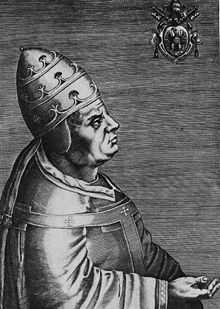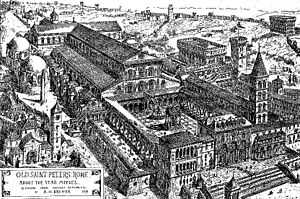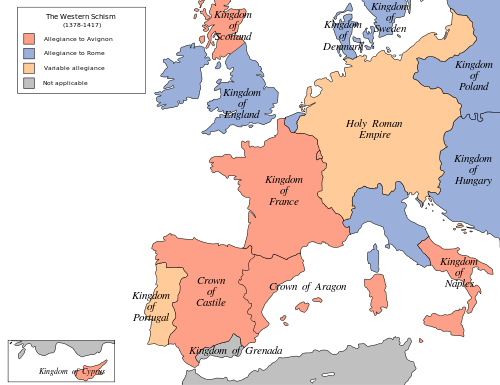Papal conclave, 1378
| Papal conclave April 1378 | |
|---|---|
 Coat of arms during the vacancy of the Holy See | |
| Dates and location | |
|
7–9 April 1378 Old St. Peter's Basilica, Papal States | |
| Key officials | |
| Dean | Ange de Grimoard |
| Sub-Dean | Pietro Corsini |
| Protodeacon | Hugues de Saint-Martial |
| Elected Pope | |
|
Bartolomeo Prignano (Name taken: Urban VI) | |
 | |
The papal conclave from April 7 to 9, 1378 was the papal conclave which was the immediate cause of the Western Schism in the Catholic Church. The conclave was one of the shortest in the history of the Catholic Church.[2] The conclave was also the first held in the Vatican and in Old St. Peter's Basilica (the elections and conclaves in Rome prior to the Avignon Papacy having been held mostly in the Basilica of St. John Lateran) since 1159.[3]
Pope Gregory XI died on March 26, 1378 in Rome, having returned from Avignon to pursue his territorial interests in the Papal States during the War of the Eight Saints. Although the French cardinals constituted a majority of the College of Cardinals due to the preceding Avignon Papacy, they succumbed to the will of the Roman mob, which demanded the election of an Italian pontiff. They elected Bartolommeo Prignano, who took the name Pope Urban VI. This was the last time a non-cardinal was elected pope.[4]
Proceedings

Before his death, Gregory XI substantially loosened the laws of the conclave: he instructed the cardinals to begin immediately after his death (rather than waiting the nine days prescribed by the Ordo Romanis) to prevent "factional coercion", he gave the cardinals permission to hold the conclave outside of Rome and move it as many times as necessary, and also seemingly suspended the two-thirds requirement, replacing it with "the greater part" (an ambiguous statement, in the original).[5]
The cardinals were divided into three factions: the first constituting the four Italian cardinals (two Romans, one Florentine, and one Milanese), the second constituting the seven "Limoges" cardinals (referred to individually as "Limousins"[1]), and the third constituting the five remaining French cardinals.[2] The conclave was delayed one day because of a violent storm, and thereafter the seven Limoges cardinals wishing to leave Rome as Gregory XI had authorized them to were persuaded by the others that such an act would place the College in even more danger.[1] It was midnight on the second day before the servants of the cardinals succeeded in clearing the Old Basilica of those not permitted to remain in the conclave.[1]
According to the Catholic Encyclopedia, even Robert of Geneva (future Antipope Clement VII) and Pedro Martínez de Luna y Gotor (future Antipope Benedict XIII)—the two claimants of the Avignon line during the ensuing Schsim—were among those who voted for Prignano.[2] Prignano had previously lived in France, which may have softened the blow of his election to many of his French electors.[6] The selection was supposedly "unanimous", with the exception of Giacomo Orsini, who claimed that he was not "free" enough to vote.[2]
Prignano was accompanied by several other prelates (to conceal the identity of the selected candidate) to the Vatican to accept his election.[2] To further the confusion, Orsini gave the Habemus Papam without identifying Prignano.[2]
Upon the conclusion of the election, the Roman mob entered the site of the conclave, under the impression that an aged Roman cardinal Tebaldeschi (who had been left in possession of the papal insignia[2]) had been elected, an impression that the remaining cardinals did not disabuse them of as they fled to their personal quarters.[7] The remaining cardinal informed the crowd of the election of Prignano who was hiding in the "most secret room" until his election could be announced.[8]
Cardinal electors
Sixteen of the twenty-three active cardinals took part in the conclave. Two possible other cardinals—Piero Tornaquinci and Pietro Tartaro—were not accepted into the ranks of the College for the election. Six more cardinals remained in Avignon, and Jean de la Grange was absent as well.[4]
| Elector | Nationality | Cardinalatial order and title | Elevated | Elevator | Other ecclesiastical titles | Notes |
|---|---|---|---|---|---|---|
| Pietro Corsini | Florentine | Cardinal-bishop of Porto e Santa Rufina | 1370, June 7 | Urban V | Sub-dean of the Sacred College of Cardinals | |
| Jean du Cros | French | Cardinal-bishop of Palestrina | 1371, May 30 | Gregory XI | Grand penitentiary | Cardinal-nephew |
| Guillaume d'Aigrefeuille, iuniore, O.S.B. | French | Cardinal-priest of S. Stefano al Monte Celio | 1367, May 12 | Urban V | Camerlengo of the College of Cardinals | |
| Francesco Tebaldeschi | Roman | Cardinal-priest of S. Sabina | 1368, September 22 | Urban V | ||
| Bertrand Lagier, O.F.M. | French | Cardinal-priest of S. Cecilia | 1371, May 30 | Gregory XI | ||
| Robert de Genève | French | Cardinal-priest of Ss. XII Apostoli | 1371, May 30 | Gregory XI | Future Antipope Clement VII | |
| Simone Borsano | Milanese | Cardinal-priest of Ss. Giovanni e Paolo | 1375, December 20 | Gregory XI | ||
| Hugues de Montelais, le jeune | French | Cardinal-priest of Ss. IV Coronati | 1375, December 20 | Gregory XI | ||
| Gui de Maillesec | French | Cardinal-priest of S. Croce in Gerusalemme | 1375, December 20 | Gregory XI | Cardinal-nephew | |
| Pierre de Sortenac | French | Cardinal-priest of S. Lorenzo in Lucina | 1375, December 20 | Gregory XI | ||
| Gérard du Puy, O.S.B. | French | Cardinal-priest of S. Clemente | 1375, December 20 | Gregory XI | Cardinal-nephew | |
| Giacomo Orsini | Roman | Cardinal-deacon of S. Giorgio in Velabro | 1371, May 30 | Gregory XI | ||
| Pierre Flandrin | French | Cardinal-deacon of S. Eustachio | 1371, May 30 | Gregory XI | Vicar of Rome | |
| Guillaume Noellet | French | Cardinal-deacon of S. Angelo in Pescheria | 1371, May 30 | Gregory XI | ||
| Pierre de Vergne | French | Cardinal-deacon of S. Maria in Via Lata | 1371, May 30 | Gregory XI | ||
| Pedro Martínez de Luna y Gotor | Aragonese | Cardinal-deacon of S. Maria in Cosmedin | 1375, December 20 | Gregory XI | Future Antipope Benedict XIII |
Absentee cardinals
| Elector | Nationality | Cardinalatial order and title | Elevated | Elevator | Other ecclesiastical titles | Notes |
|---|---|---|---|---|---|---|
| Pierre de Monteruc | French | Cardinal-priest of S. Anastasia | 1356, December 23 | Innocent VI | Vice-Chancellor of the Holy Roman Church; protopriest | Remained in Avignon; Cardinal-nephew |
| Jean de Blandiac | French | Cardinal-bishop of Sabina | 1361, September 17 | Innocent VI | Remained in Avignon | |
| Gilles Aycelin de Montaigu | French | Cardinal-bishop of Frascati | 1361, September 17 | Innocent VI | Remained in Avignon | |
| Hugues de Saint-Martial | French | Cardinal-deacon of S. Maria in Portico | 1361, September 17 | Innocent VI | Protodeacon; archpriest of the Vatican Basilica | Remained in Avignon |
| Ange de Grimoard, C.R.S.A. | French | Cardinal-bishop of Albano | 1366, September 18 | Urban V | Dean of the College of Cardinals; archpriest of the Lateran Basilica | Remained in Avignon; Cardinal-nephew |
| Guillaume de Chanac, O.S.B. | French | Cardinal-priest of S. Vitale | 1371, May 30 | Gregory XI | Remained in Avignon | |
| Jean de la Grange, O.S.B. | French | Cardinal-priest of S. Marcello | 1375, December 20 | Gregory XI | Papal legate in Tuscany |
Aftermath

The following September, the French cardinals reunited in Avignon, moved to Fondi, and elected Antipope Clement VII, who gained the support of all thirteen of his electors (at the time the entire College numbered twenty-two due to the death of Francesco Tebaldeschi).[4]
Sources
Inquisitor Nicholas Eymerich witnesses the conclave, and then went on to write one of the first tracts against Urban VI, Tractatus de potestate papali (1383), which argued in favor of the legitimacy of the Avignon line of papal claimants.[9] Several other eye-witnesses record the chant of the Roman crowd: "We want a Roman or at least an Italian" (Italian: Romano lo volemo, o al manco Italiano).[7] The contemporary curial document Factum Urbani attests to the general atmosphere of confusion, fear, and panic.[8] For example, canonist Gilles Bellemère recounts removing his clerical garb for fear of the mob and the constant ringing of bells.[8]
Pro-Urban sources—such as Alfonso de Jaén, the confessor of Bridget of Sweden, her daughter Catharine, and Dietrich of Nieheim—claim that the situation in Rome was less restless.[8] The marked discrepancy between the classes of sources can be explained by the fact that the alleged duress of the mob became the primary argument in favor of the legitimacy of the Avignon claimants.[8]
Notes
- ↑ 1.0 1.1 1.2 1.3 Baumgartner, 2005, p. 56.
- ↑ 2.0 2.1 2.2 2.3 2.4 2.5 2.6
 "Pope Urban VI" in the 1913 Catholic Encyclopedia.
"Pope Urban VI" in the 1913 Catholic Encyclopedia. - ↑ Miller, William. 1902. Mediaeval Rome, from Hildebrand to Clement VIII, 1073-1600. G. P. Putnam's sons. p. 150.
- ↑ 4.0 4.1 4.2 Miranda, Salvador. 1998. "Papal elections of the 14th Century (1303-1394)".
- ↑ Baumgartner, 2005, p. 55.
- ↑ Williams, Henry Smith. 1904. The Historians' History of the World. Outlook Company. p. 249.
- ↑ 7.0 7.1 Blumenfeld-Kosinski, 2006, p. 3.
- ↑ 8.0 8.1 8.2 8.3 8.4 Blumenfeld-Kosinski, 2006, p. 4.
- ↑ Blumenfeld-Kosinski, 2006, p. 57.
References
- Baumgartner, Frederic J. 2005. Behind Locked Doors. Macmillan. ISBN 0-312-29463-8.
- Blumenfeld-Kosinski, Renate . 2006. Poets, Saints, and Visionaries of the Great Schism, 1378-1417. Penn State Press. ISBN 0-271-02749-5.
| Popes of the Western Schism |
|---|
 |
| |||||||||||||||||||||||||||||||||||||||||